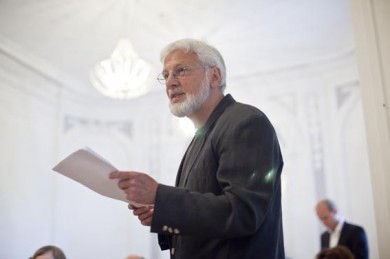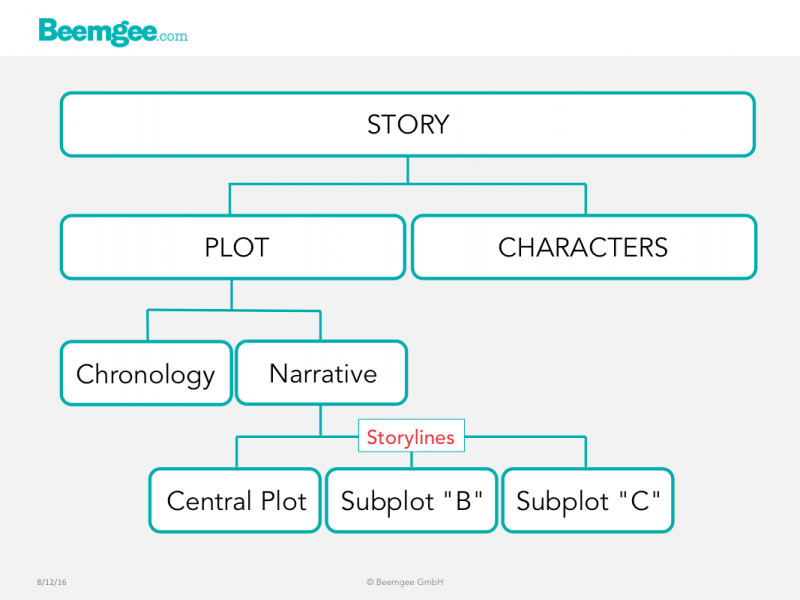Reflections on dialectically guided writing, or: Can dialectics help us tell better stories?
 Guest post by Richard Sorg.
Guest post by Richard Sorg.
Prof. Dr. phil. Richard Sorg, born in 1940, is an expert in dialectics. What is that, and what does it have to do with my novel? Well, “All great, moving and convincing stories are inconceivable without the central significance of the contradictions and conflicts that represent the driving energy of movement and development.” This puts us in the middle of dialectics. And of storytelling.
After studying theology, sociology, political science and philosophy in Tübingen, West Berlin, Zurich and Marburg, Richard Sorg taught sociology in Wiesbaden and Hamburg. His book “Dialectical Thinking” was recently published by PapyRossa Verlag. (Photo: Torsten Kollmer)
Ideas that contain a potential for conflict.
Sometimes there is a single but central chord at the beginning of a piece of music, even an entire opera, which is then gradually unfolded. Its inherent aspects, harmonies and dissonances emerge from the chosen, sometimes inconspicuous beginning, undergoing a dramatic, conflictual development, so that a whole, complex story emerges at the end of the path of this simple chord after its unfolding. This is the case, for example, with the so-called Tristan chord at the beginning of Richard Wagner’s opera “Tristan und Isolde”, a leitmotif chord that ends with an irritating dissonance.
The beginning of a story is sometimes an idea, an idea which you may not know how to develop. But some such ideas or beginnings carry a potential within them that is capable of unfolding and which holds unimagined development possibilities. ‘Candidates’ for viable beginnings – comparable to the dissonant Tristan chord mentioned above – are those that contain a potential for conflict or contradiction within. But it can also be a calm with which the matter is opened up, a calm that may then prove to be deceptive. We also find something similar in some dramas, for example with Bertolt Brecht.
And with that, we are already in the middle of dialectics. (more…)
Conflict is the lifeblood of story.
In real life, conflict is something we generally want to avoid. Stories, on the other hand, require conflict. This discrepancy is an indicator of the underlying purpose of stories as a kind of training ground, a place where we learn to deal with conflict without having to suffer real-life consequences.
In this post we will look at:
- An Analogy
- Archetypal conflict in stories
- Conflict between characters
- Conflict within a character
- The central conflict
Along with language (in some form or other, be it as text or as the language of a medium, such as film) and meaning (intended by the author or understood by the recipient), characters and plot form the constituent parts of story. It is impossible to create a story that does not include these four components – even if the characters are one-dimensional and the plot has no structure. However, it is formally possible to compose a story with no conflict.
It just won’t be very interesting.
(more…)
A plot arises out of the actions and interactions of the characters.
On the whole, you need at least two characters to create a plot. Add even more characters to the mix, and you’ll have possibilities for more than one plot.
Most stories consist of more than one plot. Each such plot is a self-contained storyline.

The Central Plot
Often there is a central plot and at least one subplot. The central plot is usually the one that arcs across the entire narrative, from the onset of the external problem (the “inciting incident” for one character) to its resolution. This is the plot that is at the(more…)
In stories, the characters’ emotions are ultimately the sources of their actions, because motivations are ultimately based on emotions.
Determining the emotional core of a character in a story may lead to a clearer understanding of that character’s behaviour, i.e. their actions.
What we’re getting at here is essentially a premise for creating a story. We have noted that if you plonk a group of contrasting characters in a room – or story-world –, then a plot can emerge out of the arising conflicts of interest. If you’re designing a story, one approach is to create the contrasts between the characters (their essential differences of character) by giving each character a core emotion. One character may be frivolous, another penny-pinching. One may be fearful, another cheeky.
You might object: Isn’t that a bit one-dimensional? Aren’t characters with just one core emotion flat?
Not necessarily. Focusing on one core emotion is not a cheap trick. It is as old as storytelling.
Classical Storytelling
Ancient(more…)
A character in a story has beliefs, values, ideas, passions. In short, an emotional stance. It’s this bundle of feelings that make the character a character.
By emotional stance we mean belief-system and value-set. This is particularly important when one considers that often stories show value-sets in conflict, and the theme of the story may present one of these value-sets as preferable over the other.
An emotional stance does not emerge in a vacuum. Stories exhibit cause and effect, and the emotional stance of the characters is no exception. A character’s emotional stance has causes. Since we’re talking about emotions, they can be hard to pinpoint – while at the same time being somewhat obvious.
As an example, take a contrast story like In The Heat Of The Night. The Police Chief in the USA’s deep south is a racist bigot. That is his emotional stance, and for the purpose of this story also his internal problem. That he is a racist does not surprise the audience at all. It is completely credible given his origins. He comes from an area where, at the time at least, such bigotry was rife.
What we’re getting at here is that the emotional stance a character displays has to be made plausible to the audience, which may be achieved by making the origins of that character explicit. In many stories, where a character comes from has to be(more…)
Stories need characters. What the characters do creates the plot.
With a well-rounded cast of characters, the plot will almost take care of itself. A story gets energy from the dynamic that occurs between the all the characters in it. The interaction between the characters is fueled by contrast, motivations, and conflict. Put a bunch of characters in a room – i.e. on a stage, between the covers of a book, between the first and last shots of a movie – and the plot is likely to emerge on its own. As long as there are contrasts between the characters and their motivations, conflict will arise.
So how does an author cast the characters that bring the story to life?
First of all, one character is rarely enough. Almost all stories need several characters. Even Robinson Crusoe couldn’t hold out alone. It’s the interplay between characters that creates interest. For interplay, read conflict.
Conflict in storytelling does not mean fights and battles. It means a conflict of interests.
Characters become characters because they have interests. Their interests make them do what they do, and this doing is what drives the plot.
What does that mean?
It means characters are motivated. They(more…)
 Guest post by Richard Sorg.
Guest post by Richard Sorg.
